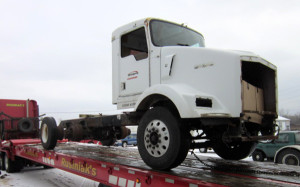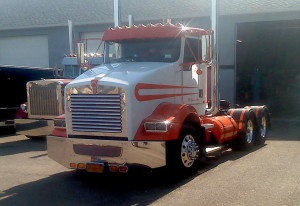 You can’t always buy what you want in a truck, motorcycle, Jeep, boat or car, so the best way to correct that is to build it yourself. Many of you who read this article will say, “I’m not mechanically-inclined and could never build a truck.” I disagree. Those of us who work on trucks still had to learn one bolt at a time, just like you will have to learn. But yes, you can build a truck – if you try. Carl Kellner, an owner-operator, built this cool white and orange 2002 Kenworth T-800 seen here, in addition to some other cool rides – and he had to learn how to do it all by himself.
You can’t always buy what you want in a truck, motorcycle, Jeep, boat or car, so the best way to correct that is to build it yourself. Many of you who read this article will say, “I’m not mechanically-inclined and could never build a truck.” I disagree. Those of us who work on trucks still had to learn one bolt at a time, just like you will have to learn. But yes, you can build a truck – if you try. Carl Kellner, an owner-operator, built this cool white and orange 2002 Kenworth T-800 seen here, in addition to some other cool rides – and he had to learn how to do it all by himself.
Carl was 25 years old when he decided to build an F350 Ford into a hot-shot truck. He knew nothing about mechanical work – his father was not mechanically-inclined and Carl didn’t even get his first car until he was 19 years old. But, he had a dream, and he followed that dream. He later built a beautiful 2000 Peterbilt 379, powered by a 2WS Caterpillar engine, with every Pittsburgh Power item available for the Cat. The truck is equipped with an 18-speed transmission and the rear gears are 2:64, which makes this Peterbilt an “unlimited” truck.
What is an “unlimited” truck, you ask? An unlimited truck is a rig that has been set-up with virtually no limits on speed and power. Carl still has this Pete, which is equipped with a Pittsburgh Power Cat Box. All Carl has to do is turn the dial for more power, and with the 2:64 gears, he still has one full gear left in the transmission, so whatever speed and power he desires, it’s available to him. Over the years we at Pittsburgh Power have built (and helped others build) many “unlimited” semi-trucks.
So, why did Carl build the T-800 Kenworth if he still has the 379 Peterbilt? No longer running over-the-road, Carl now has a local grocery run, which keeps him more in the city. Because of this, he wanted a day cab truck with a short wheelbase, powered by a smaller C-12 Caterpillar, along with a tighter turning radius. Why a C-12 Cat? Because of his experience with the 15-liter 2WS Cat in his Peterbilt, he knew he could install the Pittsburgh Power equipment to this smaller engine and still have plenty of power (and great fuel mileage).
 When Carl found the 2002 Kenworth it had only 320,000 original miles and was equipped with a 10-speed transmission – which will just not do, especially after you’ve had a 13-speed or 18-speed. Carl Kellner is a 100% type of guy, and he gives 100% to everything he does. The T-800, even though it was in good condition, needed to be taken apart and rebuilt the “Kellner” way. Yes, this Kenworth is another “unlimited” truck, which now features 2:64 rear gears, an 18-speed transmission, a Pittsburgh Power Cat Box, and a Full Tilt ported and ceramic-coated exhaust manifold. Carl also installed a Pittsburgh Power high-flow turbo, a torsional damper and mercury-filled engine balancer, a FASS fuel system, Fleet-Air filters and a Dura-Lite charge air cooler.
When Carl found the 2002 Kenworth it had only 320,000 original miles and was equipped with a 10-speed transmission – which will just not do, especially after you’ve had a 13-speed or 18-speed. Carl Kellner is a 100% type of guy, and he gives 100% to everything he does. The T-800, even though it was in good condition, needed to be taken apart and rebuilt the “Kellner” way. Yes, this Kenworth is another “unlimited” truck, which now features 2:64 rear gears, an 18-speed transmission, a Pittsburgh Power Cat Box, and a Full Tilt ported and ceramic-coated exhaust manifold. Carl also installed a Pittsburgh Power high-flow turbo, a torsional damper and mercury-filled engine balancer, a FASS fuel system, Fleet-Air filters and a Dura-Lite charge air cooler.
The end result of Carl’s efforts is a truck that gets 8.8 to 9.0 miles per gallon running local. And, as for power, on the Pittsburgh Power chassis dyno, the little C-12 put a whopping 729 horsepower to the ground with the Cat Box only on Power Level 5. Carl wanted to see what the little Cat would do on power level 7, but I told him 729 is enough, let’s not push it. Carl does not run the Power Box on setting 5, however he does run it on Level 3, which produces 550 horsepower to the ground (which is 647 flywheel horsepower). Needless to say, this little day cab Kenworth never runs out of power and still gets great fuel mileage, which also has a lot to do with Carl’s right foot, and the fact that he knows how to drive it properly, with a soft foot on the gas pedal.
Jim Shimo was the mechanic who worked with Carl for two years, in their spare time, to build this efficient and useful little Kenworth. When Carl went to pay him for his services, he would not accept any money. Instead, he wanted Carl’s 2003 100th Anniversary Harley Davidson Ultra Classic motorcycle. Carl had three Harleys at the time, so he graciously let this one go and handed over the keys to Jim. Carl paid $7,000 for the T-800 and then invested another $46,000 in paint and parts, plus the 2003 Harley Ultra Classic. But, not a day goes by that someone doesn’t say to Carl, “Hey, nice looking ride!”
Next year, Carl will begin rebuilding his 2000 Pete 379, which he bought new. If you know the Pete, you know it is still in beautiful condition, however after 17 years of service, it’s not quite 100% anymore. Carl plans to change that. How? By doing it the old-school way – himself!
Here is an update on “Dorothy” – she is now in production, and the first 24 units should be ready by the beginning of September. For those of you who do not know who or what “Dorothy” is, she is our new invention, a uniquely-designed canister designed to remove most of the soot from EGR engines. There are about 15 of these canisters on trucks as of the time of this writing, and all are performing well, creating fuel mileage gains of .7 to 1.0 mpg, along with a 30% decrease in the use of DEF, and drastically reduced regens of the diesel particulate filter (DPF).
The only maintenance required to “Dorothy” is a simple cleaning process that needs to be done about every 30,000 to 40,000 miles. All you have to do is remove one clamp, remove the canister, dump the soot in a trash can, and then reinstall the canister. That’s it – there are no moving parts. The cleaning action required to remove the soot is accomplished by creating a tornado-type action in the canister, thus the name Dorothy. Now, you can enjoy a brand-new truck. Just install a Dorothy on your rig, and the emissions system will perform trouble-free for years to come. If you own a 2003 or newer engine with EGR, you NEED this product!
Sometimes, the best way to make sure something gets done right is to do it yourself. If you are new to this philosophy, we are here to help. Trust yourself and learn something new, because knowledge is power! If you have questions or want to learn more about our products and services, call (724) 360-4080 or visit www.pittsburghpower.com today.
